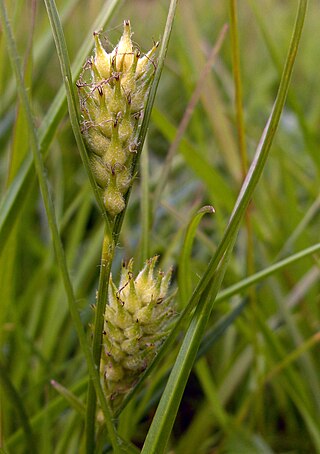
Ornamental grasses are grasses grown as ornamental plants. Ornamental grasses are popular in many colder hardiness zones for their resilience to cold temperatures and aesthetic value throughout fall and winter seasons.

Eduard Friedrich Poeppig was a German botanist, zoologist and explorer.

The silvery woolly monkey, also known as Poeppig's woolly monkey or the red woolly monkey, is a subspecies of the common woolly monkey from South America. Named after the German zoologist Eduard Friedrich Poeppig, it is found in Brazil, Ecuador and Peru.

Carex is a vast genus of nearly 2,000 species of grass-like plants in the family Cyperaceae, commonly known as sedges. Other members of the family Cyperaceae are also called sedges, however those of genus Carex may be called true sedges, and it is the most species-rich genus in the family. The study of Carex is known as caricology.

Rhinella poeppigii is a species of toad in the family Bufonidae that is known from the eastern Andean slopes of Ecuador, Peru, and Bolivia, as well as from Serranía de Sira in Amazonian Peru. Its distinctiveness from Rhinella marina has been debated, but it is currently accepted as a valid species. It is named after Eduard Friedrich Poeppig, German botanist and naturalist who made scientific expeditions to South America.

Maihuenia poepigii, commonly known in Chile as maihuén or hierba del guanaco, is a succulent cactus shrub native to Chile and Argentina. M. poepigii is remarkably tolerant to moisture and cold temperatures.

Carex riparia, the greater pond sedge, is a species of sedge found across Europe and Asia. It grows in a variety of wet habitats, and can be a dominant species in some swamps. It is Britain's largest Carex, growing up to 130 cm tall, with glaucous leaves up to 160 cm long. It hybridises with a number of other Carex species, including the closely related Carex acutiformis – the lesser pond sedge. A variegated cultivar is grown as an ornamental grass.

Carex hirta, the hairy sedge or hammer sedge, is a species of sedge native across Europe. It has characteristic hairy leaves and inflorescences, and is the type species of the genus Carex.

Carex sect. Ovales is a section of the genus Carex, containing around 85 species of sedge. It is the most diverse section of the genus in North America, containing 72 species:

Carex subg. Carex is a subgenus of the sedge genus Carex. It is the largest of the four traditionally recognised subgenera, containing around 1400 of the 2000 species in the genus. Its members are characterised by the presence of one or more exclusively male (staminate) terminal spikes, quite dissimilar in appearance from the lateral female (pistillate) spikes below. In most species, the female flowers have three stigmas, but a few species, including Carex nigra, have female flowers with only two stigmas.

Carex subg. Vignea is a subgenus of the sedge genus Carex, containing around 300 of the 2000 species in the genus. Its members are characterised by having bisexual, sessile spikes, where the female flowers have two stigmas each.
A. poeppigii may refer to:
C. poeppigii may refer to:
E. poeppigii may refer to:

Hypolepis poeppigii is a fern species in the family Dennstaedtiaceae that has no common name. It is native to Chile and the Falkland Islands.
L. poeppigii may refer to:
S. poeppigii may refer to:
W. poeppigii may refer to:










